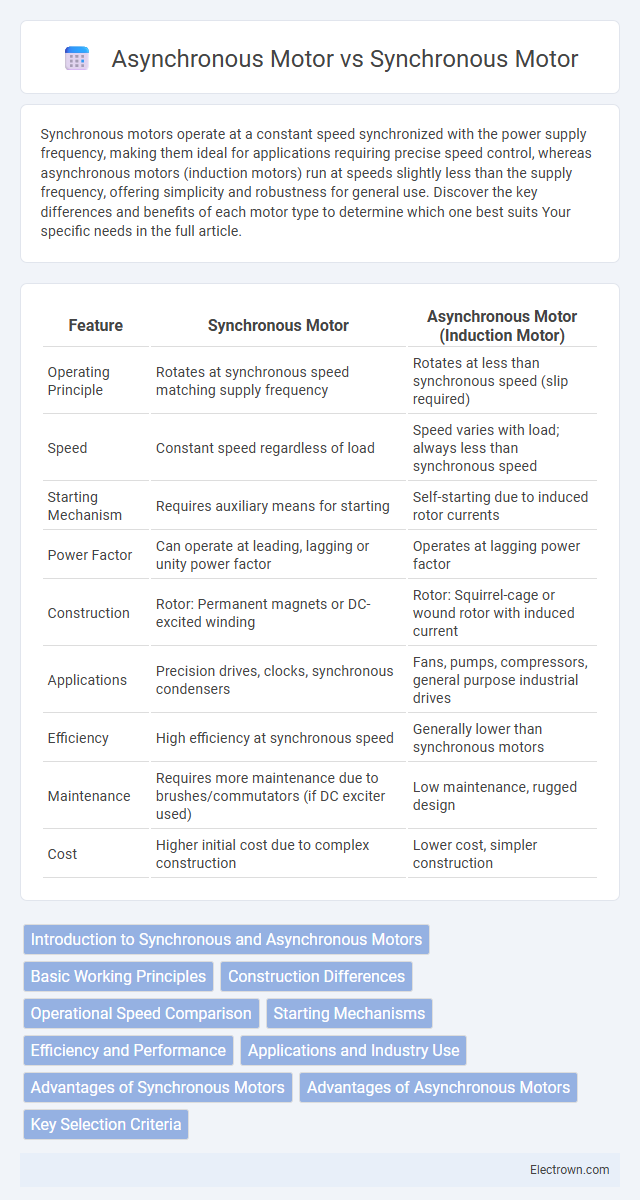Synchronous motors operate at a constant speed synchronized with the power supply frequency, making them ideal for applications requiring precise speed control, whereas asynchronous motors (induction motors) run at speeds slightly less than the supply frequency, offering simplicity and robustness for general use. Discover the key differences and benefits of each motor type to determine which one best suits Your specific needs in the full article.
Table of Comparison
| Feature | Synchronous Motor | Asynchronous Motor (Induction Motor) |
|---|---|---|
| Operating Principle | Rotates at synchronous speed matching supply frequency | Rotates at less than synchronous speed (slip required) |
| Speed | Constant speed regardless of load | Speed varies with load; always less than synchronous speed |
| Starting Mechanism | Requires auxiliary means for starting | Self-starting due to induced rotor currents |
| Power Factor | Can operate at leading, lagging or unity power factor | Operates at lagging power factor |
| Construction | Rotor: Permanent magnets or DC-excited winding | Rotor: Squirrel-cage or wound rotor with induced current |
| Applications | Precision drives, clocks, synchronous condensers | Fans, pumps, compressors, general purpose industrial drives |
| Efficiency | High efficiency at synchronous speed | Generally lower than synchronous motors |
| Maintenance | Requires more maintenance due to brushes/commutators (if DC exciter used) | Low maintenance, rugged design |
| Cost | Higher initial cost due to complex construction | Lower cost, simpler construction |
Introduction to Synchronous and Asynchronous Motors
Synchronous motors operate at a constant speed synchronized with the supply frequency, providing precise speed control and high efficiency ideal for applications requiring exact timing. Asynchronous motors, also known as induction motors, run slightly slower than the supply frequency, offering robustness and simplicity that make them widely used in industrial machinery. Your choice between synchronous and asynchronous motors depends on the need for speed accuracy versus cost-effectiveness and maintenance simplicity.
Basic Working Principles
Synchronous motors operate by rotating at a constant speed synchronized with the supply frequency, using a rotor with a direct current (DC) excitation to create a steady magnetic field that locks in with the stator's rotating magnetic field. Asynchronous motors, also known as induction motors, work on the principle of electromagnetic induction where the rotor speed lags behind the stator's rotating magnetic field, inducing current in the rotor to produce torque. The key difference lies in synchronous motors maintaining a fixed speed while asynchronous motors have slip, causing their rotor speed to be slightly less than the synchronous speed.
Construction Differences
Synchronous motors feature a rotor with permanent magnets or DC-excited windings that rotate at synchronous speed, directly matching the frequency of the supply current. Asynchronous motors, also called induction motors, have a squirrel-cage or wound rotor where the rotor speed is slightly less than synchronous speed, creating relative motion that induces current. The key construction difference lies in the rotor design and excitation methods, with synchronous motors requiring external DC supply or permanent magnets, while asynchronous motors rely on induction from the stator's rotating magnetic field.
Operational Speed Comparison
Synchronous motors operate at a constant speed directly linked to the supply frequency and rotor pole count, ensuring zero slip during operation. Asynchronous motors, or induction motors, run at speeds slightly less than synchronous speed, with slip necessary to induce rotor current and torque production. The inherent slip in asynchronous motors results in variable speed under load, whereas synchronous motors maintain precise, stable speed ideal for applications requiring exact timing.
Starting Mechanisms
Synchronous motors require external starting mechanisms such as pony motors or variable frequency drives to bring the rotor up to synchronous speed before locking in, as they cannot start on their own. Asynchronous motors, or induction motors, utilize electromagnetic induction for self-starting, where the rotor currents generate torque directly when power is applied. Understanding these starting mechanisms helps you select the appropriate motor type for applications requiring specific starting performance and control.
Efficiency and Performance
Synchronous motors generally offer higher efficiency and superior performance at constant speeds due to their ability to maintain synchronous speed under varying loads, reducing slip and energy loss. Asynchronous motors, or induction motors, are less efficient at varying speeds because slip causes additional losses, but they provide robust performance with simpler construction and lower maintenance costs. In industrial applications requiring precise speed control and high efficiency, synchronous motors are preferred, while asynchronous motors excel in cost-sensitive, variable-load environments.
Applications and Industry Use
Synchronous motors are widely used in applications requiring precise speed control, such as robotics, conveyor systems, and power factor correction in industrial plants. Asynchronous motors, or induction motors, dominate heavy-duty sectors like manufacturing, HVAC systems, and pumps due to their ruggedness and cost-effectiveness. Understanding the strengths of each motor type helps you select the right solution for efficient operation and industry-specific demands.
Advantages of Synchronous Motors
Synchronous motors offer precise speed control by maintaining a constant speed regardless of load, making them ideal for applications requiring accurate timing. They exhibit high efficiency and power factor correction capabilities, reducing energy losses and improving overall system performance. Their ability to operate at leading or unity power factor helps in enhancing the stability of electrical grids and reducing demand charges.
Advantages of Asynchronous Motors
Asynchronous motors offer robust construction, low maintenance, and high reliability, making them ideal for industrial applications with variable loads. Their simple design eliminates the need for brushes and slip rings, reducing operational costs and increasing lifespan. You benefit from efficient starting capabilities and cost-effective operation compared to synchronous motors.
Key Selection Criteria
Key selection criteria between synchronous and asynchronous motors include application speed control, efficiency, and power factor correction. Synchronous motors excel in precise speed regulation and power factor improvement, making them suitable for high-precision industrial applications and power systems requiring constant speed. Asynchronous motors, commonly known as induction motors, offer robustness, simpler construction, and cost-effectiveness, ideal for variable-speed operations and general-purpose drives.
Synchronous Motor vs Asynchronous Motor Infographic

 electrown.com
electrown.com